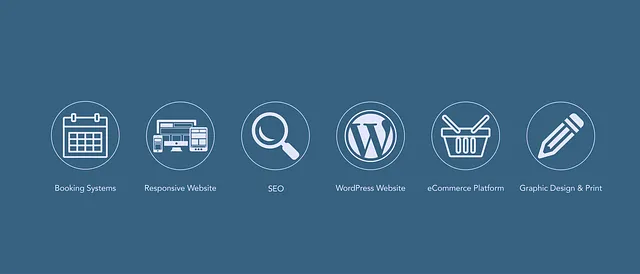Link equity distribution is a crucial aspect of WordPress SEO, impacting rankings and user experience. Effective strategies ensure internal links pass value to all pages, improving crawlability. Audits, broken link redirection, and anchor text optimization are key. Identifying weak links allows restructuring navigation and enhancing page authority flow. Tools like Google Search Console and specialized plugins help analyze and optimize link equity, leading to better SEO performance and user satisfaction. Regular updates and a logical site structure maximize overall site authority, while monitoring tools gauge improvements' success.
Struggling with a site structure plagued by broken or weak internal links? This guide is your solution. We delve into the core concept of link equity distribution for WordPress, exploring how it impacts SEO and overall website performance. Learn effective strategies to identify problematic links, strengthen your internal linking structure, and leverage powerful tools for in-depth analysis. Discover best practices for optimization and measurement techniques to track the success of your internal linking improvements.
- Understanding Link Equity and Its Impact on SEO
- Identifying Weak Internal Links in WordPress Sites
- Strategies to Strengthen Internal Linking Structure
- Tools for Efficient Link Equity Distribution Analysis
- Best Practices for Optimizing Internal Links in WordPress
- Measuring the Success of Internal Linking Improvements
Understanding Link Equity and Its Impact on SEO

Link equity, a concept often overlooked but immensely powerful, refers to the value and authority passed from one webpage to another through internal links. In the context of WordPress or any website, this equitable distribution plays a pivotal role in SEO (Search Engine Optimization). When you link from a high-authority page to a lower-quality or broken one, search engines may penalize your site, assuming it’s providing poor value to users. Conversely, strategic linking enhances user experience by guiding them to relevant content and signals to search algorithms that your site is well-organized and trustworthy.
The impact of efficient link equity distribution SEO can be profound. It improves crawlability, ensuring search engine bots can access and index all important pages. Additionally, it aids in ranking weaker pages, boosting their visibility and potential for organic traffic. For WordPress sites, implementing a robust link equity distribution strategy involves regular audits to identify broken links, redirecting these to relevant internal pages, and using anchor text judiciously to convey context and authority. A step-by-step tutorial on this process can be a valuable resource for any website owner aiming to strengthen their site’s overall SEO performance.
Identifying Weak Internal Links in WordPress Sites

Identifying weak internal links is a crucial step in optimizing your WordPress site’s structure and improving its overall link equity distribution. In WordPress, link equity represents the value passed from one page to another through incoming and outgoing links. A broken or weak internal link can disrupt this flow, potentially impacting SEO performance. To uncover these issues, it’s essential to conduct a thorough audit of your site’s navigation. Start by using built-in tools like Google Search Console or WordPress plugins designed for internal linking analysis. These tools provide insights into dead ends, missing anchors, and low-quality links that may be hindering user experience and search engine crawling.
By examining the link equity distribution SEO within your site, you can pinpoint pages with poor performance and take corrective actions. Following a comprehensive link equity distribution tutorial specific to WordPress can help guide this process. This may involve restructuring navigation menus, updating anchor text for better relevance, or even redirecting outdated links to relevant pages, ensuring every internal connection contributes positively to your website’s overall authority and user navigation.
Strategies to Strengthen Internal Linking Structure

To strengthen your internal linking structure, start by assessing and understanding the current state of your site’s architecture. Utilize WordPress tools that offer detailed insights into link equity distribution, enabling you to identify weak or broken links. This process involves a thorough audit of anchor text usage, page authority flow, and the overall efficiency of internal connections. By pinpointing problem areas, you can implement targeted strategies for optimization.
Implement changes such as updating broken links, ensuring relevant anchor texts, and creating new content that naturally incorporates internal links to important pages. Focus on optimizing link equity distribution SEO by fostering a logical hierarchy within your site. Regularly update and refresh your internal linking strategy as your website evolves, keeping search engines informed about the most valuable and relevant pages through a well-structured internal link profile.
Tools for Efficient Link Equity Distribution Analysis

In today’s digital era, maintaining a robust internal linking structure is crucial for any website’s success, especially WordPress sites looking to enhance their SEO. One significant aspect to focus on is link equity distribution, ensuring that every page on your site contributes optimally to its overall authority. Tools like Ahrefs, SEMrush, and Moz offer advanced features for in-depth analysis of this distribution. These tools provide insights into how link equity flows through your pages, allowing you to identify weak areas and optimize them accordingly.
By utilizing these tools, WordPress users can implement effective strategies, such as restructuring internal links, creating high-quality content that naturally attracts backlinks, and using anchor text variations to pass along equity evenly. Remember, a well-distributed link equity is a key factor in improving your site’s search rankings and user experience. Incorporating these tips into your SEO strategy will help you fix broken or weak internal linking issues once and for all.
Best Practices for Optimizing Internal Links in WordPress

To optimize internal links in WordPress effectively, site owners should adhere to best practices that promote a healthy link equity distribution. First and foremost, focus on creating a logical site structure with clear navigation menus. This ensures users and search engines can easily traverse your site, boosting user experience and SEO performance. Use anchor text that is descriptive and relevant, accurately representing the linked content’s purpose.
A crucial strategy for optimizing internal links is to ensure equal distribution of link equity across pages. This involves avoiding excessive linking to certain pages, as it can skew the distribution. Utilize a link equity distribution tutorial or strategy to analyze your site’s internal links and identify any weaknesses. Regularly update and adjust these links based on content freshness and relevance, ensuring a dynamic and optimized WordPress site that benefits both users and search engines alike.
Measuring the Success of Internal Linking Improvements

Measuring the success of internal linking improvements is a crucial step in understanding the impact and effectiveness of your optimizations. One of the key metrics to track is link equity distribution. For WordPress sites, this refers to how evenly and effectively link juice is distributed across your website’s pages. A well-optimized internal linking strategy ensures that valuable link equity is shared equally among relevant pages, strengthening their authority and relevance in search engine results.
Using tools like Google Search Console and SEO plugins designed for link equity distribution optimization can provide insights into how links are flowing through your site. These tools allow you to analyze anchor text usage, identify broken links, and monitor changes in link equity over time. By following a link equity distribution tutorial tailored for WordPress, you can ensure that your internal linking improvements align with best practices, leading to better search engine visibility, enhanced user experience, and ultimately, improved conversions.
